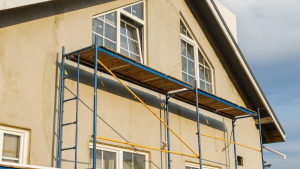Roof maintenance is generally not on the list of things to do in the spring, along with yard work and spring cleaning. However, when winter ends, your roof should be at the top of your list of home maintenance considerations.
Winter weather may cause substantial damage to your roof, and severe damage might threaten structural stability. If you want your roof to endure through the winter, you must maintain it after that.
Here are seven roof maintenance recommendations to help you get through the winter and prepare your roof for spring.
1. Have Roof Evaluated
The first thing you should do after the winter has a professional roofer evaluate your roof for damage. While you may examine your roof yourself, it may have subtle degradation indications that an unskilled eye may overlook. Furthermore, roofs are moist and slick after winter, making climbing on the roof dangerous.
To be safe, have a professional assess your roof and establish a list of all necessary repairs.
2. Check for Interior Signs of Water Damage
Water damage to your roof may be tough to spot from the outside. However, water damage to your interiors may be visible. Check the ceiling for wet stains. These may appear as brown rings. Look for bubbling or peeling paint on your walls as well.
Make repairs as soon as you see any evidence of water damage.
3. Clean Your Gutters
Cleaning your gutters before spring is vital for preventative maintenance. During the winter, debris may have blocked your gutters, making it hard for them to discharge water. You don’t want all that debris in your gutters in the spring.
If your gutters are blocked during the spring rains, water will stand on your roof or overflow, causing structural damage to your property. To avoid future obstruction, consider installing a gutter guard.
4. Check for Mold and Algae
The wetness on your roof throughout the winter provides an ideal environment for mold and algae to grow. Mold and algae may harm your roof and your health if not cleaned. If you detect mold or algae on your roof, thoroughly clean it.
5. Trim Your Trees
Overhanging branches and falling leaves and debris may break and fall on your roof during rainfall. If this happens, your roof might sustain substantial damage. Furthermore, leaves that fall on your roof may accumulate moisture, which may damage your roof and cause mold growth.
6. Replace or Repair Damaged Shingles
Damaged shingles may cause water leaks, and you want to avoid constantly wiping pools of water off your floor with the spring rains. Water leaks may also cause damage to other parts of your house, such as your ceiling, attic, and walls. Damaged shingles may also cause harm to your roof’s protective membrane, reducing its insulative capabilities.
To prevent the aforementioned issues, have your roofing professional repair or replace broken shingles before spring.
7. Examine Your Fascia Board and Flashing
The fascia is a wooden or metal board that spans the length of your roof, concealing exposed trusses and rafters. In contrast, flashing is a thin metal material used on roof connections, such as those between the roof, chimneys, and roof valleys.
Because the flashing and fascia prevent water from entering your house via roof gaps, they must be fixed promptly if they become damaged. Preventative roof maintenance is essential for extending the life of your roof and protecting your property. Contact CMB Wayne Stucco & EIFS for post-winter repairs and maintenance to keep your roof in good shape as spring comes.


